This is “Professional Writing”, chapter 12 from the book Writers' Handbook (v. 1.0). For details on it (including licensing), click here.
For more information on the source of this book, or why it is available for free, please see the project's home page. You can browse or download additional books there. To download a .zip file containing this book to use offline, simply click here.
Chapter 12 Professional Writing
Writing as a Component of Success
You probably know someone who has said, “I’m a lousy writer, but it doesn’t matter since I don’t write for a living and I’m not an English teacher.” You might have even made such a comment yourself. In reality, good writing can help you from the moment you apply for a job throughout your time in the workforce. And regardless of whether you are writing in academic or professional settings, good writing involves an awareness of voice, audience, and message.
12.1 Writing Business Letters
Learning Objectives
- Recognize key parts of a business letter.
- Learn the block format of a business letter.
- Understand the professional nature of a business letter.
You might think that people living in the age of technology do not need to learn business letter skills. After all, in today’s professional world, e-mails have replaced business letters as the primary mode of communication. However, many formal situations are still best handled with business letters, whether they are sent on paper or as an attachment to an e-mail.
When writing a business letter, if you use business letterhead that includes the company address and other contact information, you do not need to incorporate that information within the letter. The most common format of business letters, the block format, uses one-inch margins with all content flush against the left margin, including the body paragraphs. Some less common forms do use indentation. Business letters include the following parts, as shown in this sample:

When writing a business letter, keep these tips in mind:
- Do not use slang.
- Be professional.
- Be concise and to the point.
- Mention a personal connection, if you have one, briefly at the beginning of the letter to create a personalized introduction.
- Use the abbreviation “Enc.” or the word “Enclosed” prior to a list of papers that are included with the business letter.
- Proofread for grammar, punctuation, and spelling.
- Make sure that a letter attached to an e-mail is in a document format that your recipient also uses.
- Use a person’s name in the greeting whenever possible. If you have no way of acquiring a name, use “Dear Sir or Madam” or similar generic, but professional, wording.
Key Takeaways
- The block format is the most common form of a business letter.
- Business letters, whether sent in hard copy or digitally, should include date; name, position, and address of recipient; greeting; body; closing; signature; typed name; position of sender; and enclosure list if there are any enclosures.
- Business letters should be formal in tone, concise, free of errors, and personalized at a professional level.
- Business letters are often attached to e-mails. In such cases, make certain the recipient has the necessary software to open the letter.
Exercises
- Demonstrate your understanding of business letter techniques by writing a realistic mock business letter.
- Collect a sample of business letters you receive in the mail over the next few weeks. Bring the samples to class and share them with your group; look for differences and similarities in format and tone.
12.2 Writing to Apply for Jobs
Learning Objectives
- Recognize visual features of a résumé.
- Recognize content components of a résumé.
- Understand how to target a cover letter.
As part of the process of applying for any job in any profession beyond the entry level, you are likely to have to produce two main written documents: a résumé and a cover letter or letter of application. Writing these documents well is often a key determiner in whether you get the job. To illustrate, we’ll follow a student, Joey Williams, through these two key professional writing challenges. Joey is a recent graduate of a master’s degree program in public relations who is seeking a position at a graphic design firm.
Creating Solid Résumés
Common résumé formats vary with types of jobs and with the times, but regardless of the type of position you are seeking, your résumé should include some key features and some key information.
Key Résumé Features
Effective résumés have the following features:
- They are meticulously edited (absolutely no errors).
- The subheadings stand out and are short enough to be read at a glance (one or two words).
- Ample white space is used.
- Lists are parallel.
- Bolding is used sparingly.
- One easy-to-read font is uniformly used throughout.
- The font is size 12.
- The résumé is available both in digital and hard-copy form.
- Formatting on a digital résumé holds when it is opened in others’ computers. This formatting should be straight type without tabbing, tables, italics, bolding, columns, or indenting. If it’s included as an attachment, it should be in a Microsoft Word file. A second option is to visually create the résumé as desired and then capture it in a PDF file.
- The résumé is confined to one page unless you are in a profession that requires additional pages or unless you are at a more advanced professional level that requires a more extensive résumé.
- The most recent information is presented first within each category.
- Standard résumé paper is used unless the specific profession calls for something different.
- Accomplishments are presented in nonwordy formats.
- Action verbs are used to describe accomplishments.
- Contact information is clearly visible at the top of the résumé.
- Key words that searchers in your professional field are likely to use are included in résumés that are posted online. (After your contact information, include a “key words” section or weave the keywords into your accomplishments.)
Key Résumé Information
Every résumé should include the following information:
- professional name
- address
- phone number
- e-mail address
- work experience (i.e., places of employment)
- accomplishments at each place of employment
- education
These résumé components are optional:
- personal interests
- references
- dates of education and work experience
- address for personal website
- employment objective (a good strategy if you want to tailor your résumé for a certain job description)
- fax number
- awards and honors
To ensure that your résumé is both current and appropriate for the position, you should search online for similar sample résumés. You should also run your résumé past the career placement services at your college and any people you know who are working in your field of interest. Here’s Joey’s generic résumé:
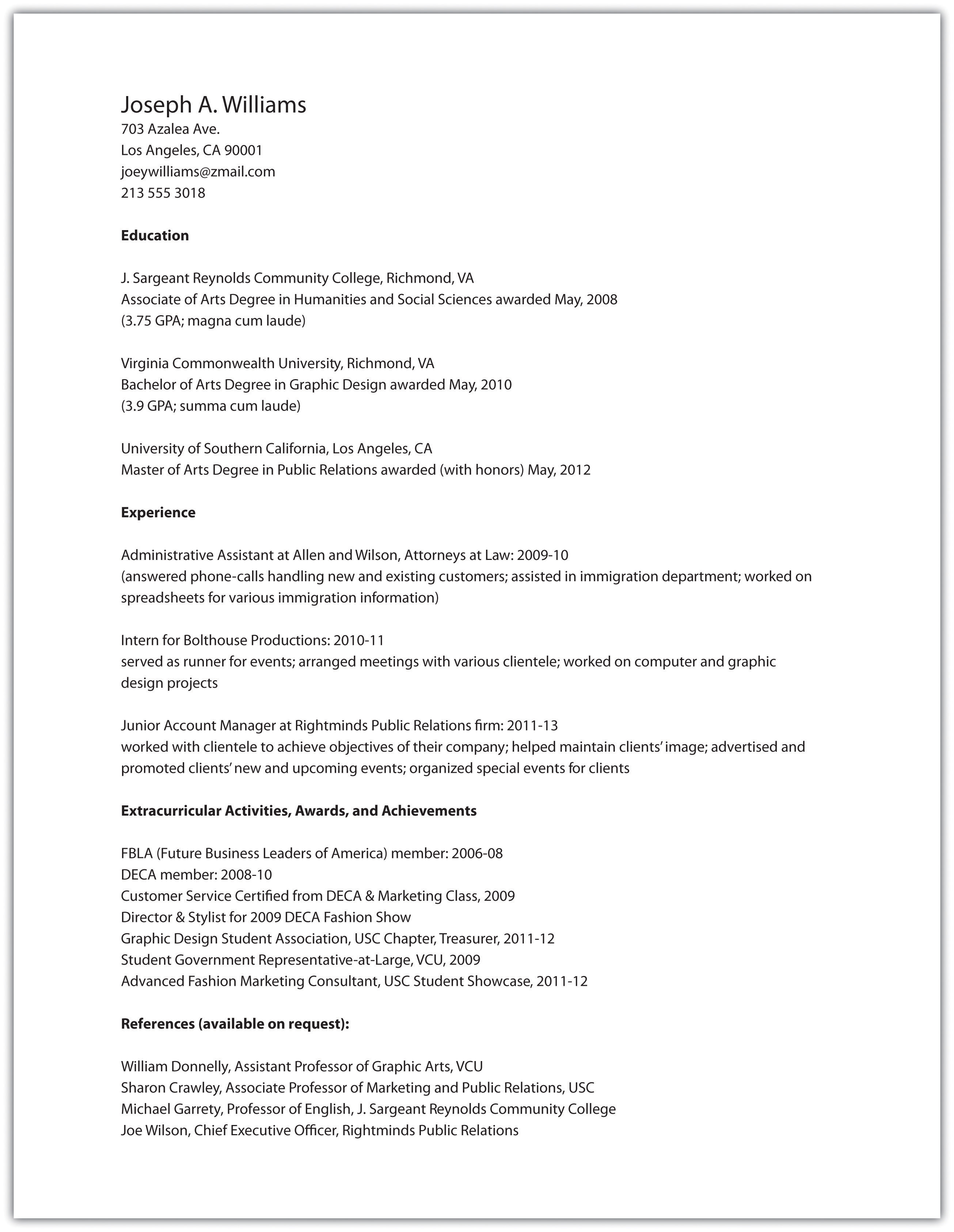
Writing Targeted Cover Letters
Along with sending a résumé when applying for a job, you will almost always want to send a cover letter. This suggestion holds true in both hard-copy and digital situations. A hard-copy cover letter should be formatted as a standard, typed business letter (for a sample, see Chapter 12 "Professional Writing", Section 12.1 "Writing Business Letters"). A digital cover letter should be either typed directly into a given window or copied and pasted into the window. If you copy and paste, check to make sure that the formatting holds.
When the job market is tight, just getting an interview is a major hurdle. Facing dozens and sometimes even hundreds of applicants, employers are looking for reasons to cut down their pool of potential interviewees. Don’t give them a reason not to interview you by writing a vaguely worded, overly general letter of application or résumé, especially when you can easily revise and tailor your approach to each position for which you are applying.
To target a cover letter means to write it specifically for an identified job. You can gather information to target your cover letter by looking carefully at the job description and by studying the company’s website. Let’s look at an example of an online job description that has caught Joey’s attention:
Video Game PR—Assistant Account Executive
About the Job
GolinHarris is a leading international public relations firm and winner of PRWeek’s Large PR Agency of the Year 2010, 2010 Best Places to Work by the Los Angeles Business Journal, and numerous industry awards.
Our western region headquarters, based in Los Angeles, is currently seeking an ambitious and motivated PR professional to join our team as an Assistant Account Executive. The successful candidate will play an integral role and receive valuable hands-on experience by working on our Nintendo account. We are launching exciting programs in the next few weeks and this opportunity will not last long. Avid gamers are encouraged to apply now.
The candidate we seek will perform fundamental PR tasks such as aiding in production of media-related materials, pitching program highlights to the media, monitoring for quality and quantity of media coverage and managing client publications and resources materials.
What Do You Need to Be Considered?
- 2 years of work experience in PR required, agency and video game background is preferred
- Applicants with only internship experience will not be considered
- A passion for communications and consumer issues
- Stellar AP-style writing abilities
- A Bachelor’s degree
- Social media experience
- Local applicants preferred
About Us
As a member of the Interpublic Group (IPG), GolinHarris partners with a network of the communication industry’s best strategists across a variety of disciplines, including sports marketing, consumer research, branding, special events and advertising. We collaborate with these partners to continually advance our clients’ businesses.
At GolinHarris we recognize that there is much more to life than just work. Our benefits program has been designed to help GolinHarris employees and their families stay healthy, balance personal and career priorities, and build a solid and secure future. We offer a great workplace, culture, competitive salary, health care benefits (medical, dental and vision insurance), 401k and more.
GolinHarris is an Equal Opportunity Employer. EEO/AA.M/F/D/V.
Source: GolinHarris
As Joey prepares his cover letter, he’ll need to include, in three or four paragraphs, information about himself and his fitness for the position that complement what his résumé already reveals. Typical contents of the paragraphs of his cover letter might include the following:
First Paragraph
- The job for which he is applying
- How he learned of the job
- A statement clearly and succinctly indicating why he is well suited for the job
Second Paragraph
- Some current, relevant experiences that show he has a good background for the job. This should be where he places the most significant points he has to offer.
Third Paragraph
- Other relevant job experiences or education. This is where he puts what might be considered his “second level” of important points.
Fourth Paragraph
- A statement about wanting to have an opportunity to discuss the job
- An offer to send references as needed
- Request to be contacted and a reiteration of his main contact information (most likely a phone number or an e-mail address or both)
Keep in mind that your cover letter is the first chance to present yourself and often the only chance. Besides being sure to include the most pertinent and valuable information you have to offer, be very careful that your letter is grammatically correct with no punctuation or spelling errors. Proofread it carefully yourself, and then, even if you think the letter is perfect, ask a trusted acquaintance to proofread it. Errors in this kind of high-stakes writing situation can be fatal to your chances of achieving your desired goal: getting your foot in the door professionally.
As he is planning his cover letter, Joey decides to apply what he has learned in his academic writing career to this all-important professional challenge. Thus, before writing, he fills out the statement of purpose he used six years before when he was a first-year college student:
| Voice | I am writing as a young, eager, well-educated, and flexible individual who wants to be a part of the GolinHarris team. |
| Message | I want to convey the message that I will bring extensive gaming, graphic design, and public relations experience and credentials to the position. |
| Audience | I want to write to the human resources department or hiring manager at GolinHarris. |
| Attitude | My attitude toward the subject is positive and confident, but also somewhat deferential, humble, and respectful of authority. |
| Reception | I want my audience to give me an interview because they realize they’ve got a hot local prospect who’s perfect for the job. |
| Tone | My tone toward my readers is professional, but creative, enthusiastic, and cutting-edge. |
Armed with his statement of purpose, Joey writes the following cover letter:
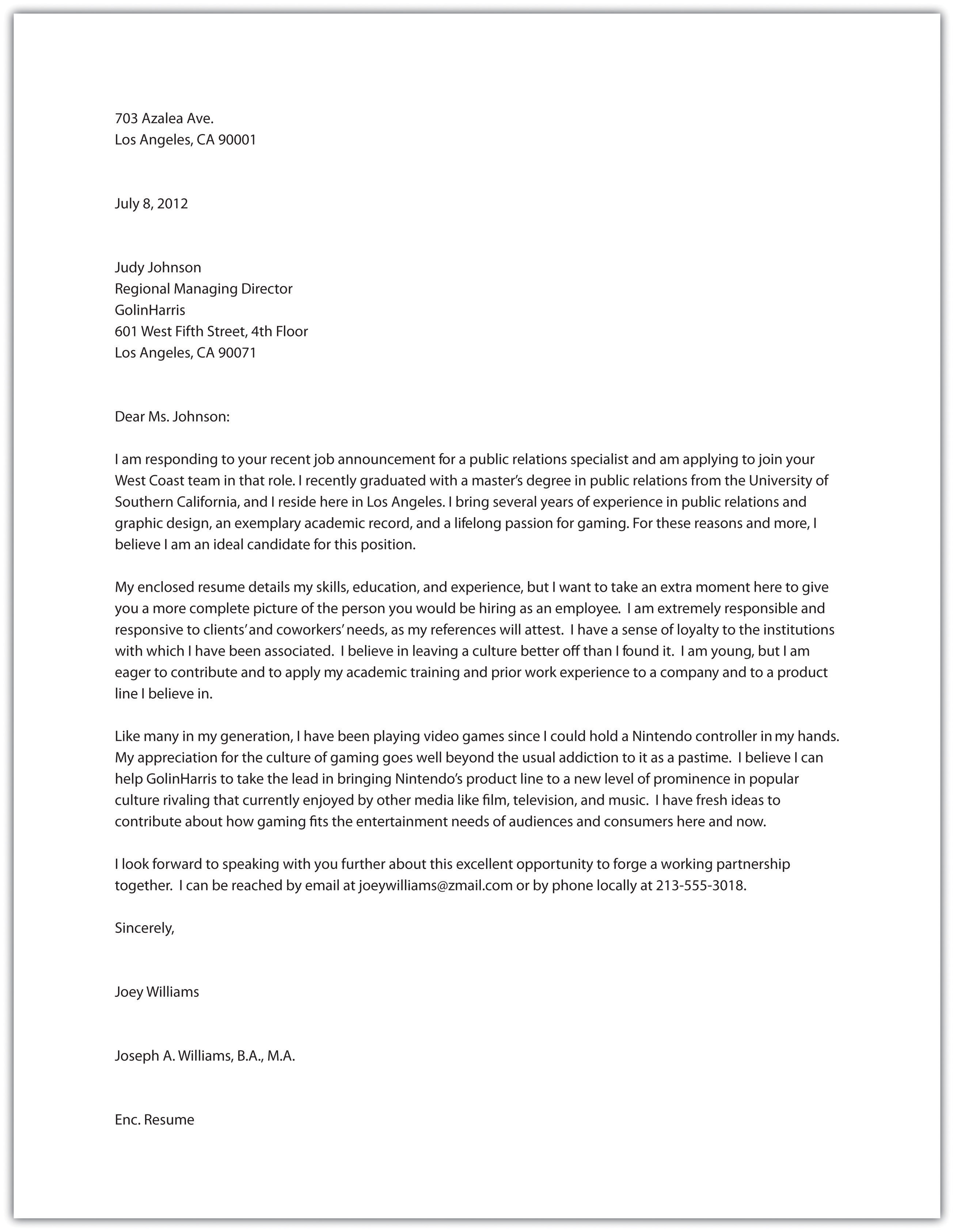
Key Takeaways
- The visual elements of résumés are important, including subheadings, white space, paper choice, font choice, and limited use of font features.
- Your résumé should be available in both print format and digital format. Digital résumés must have very little formatting. A PDF version can sometimes be used instead of a nonformatted option.
- All résumés should include your professional name, address, phone number, e-mail address, work experience, and education. You might also choose to include your personal interests, references, website address, objective, fax number, and awards and honors.
- You should always include a paper or digital cover letter with your résumé. Your cover letter should include three or four paragraphs that include the position for which you are applying, the most relevant experiences you have had that make you a good candidate for the job, a request to discuss the job, and your contact information.
- Of all the types of writing you do, perhaps none requires more meticulous attention to detail and editing than résumés and cover letters.
Exercises
- Create a résumé that you could use when applying for a specific position. Generate both a paper version and a digital version.
- Find a position description for a job that interests you and fits your current or prospective skills. Write a cover letter that you could send with your résumé to apply for that job. Before you write your cover letter, use the job description as a guide for filling out a statement of purpose.
- Working with your writing group, search online for a collection of job descriptions. Using an agreed-on selection from your sample, assign each member of your writing group the task of designing a résumé and cover letter to meet the needs of that description (with each group member “applying” under an assumed name). Then compare the submissions and determine which two applicants should be interviewed as finalists. Explain the reason for your choices.
12.3 Composing Memos
Learning Objectives
- Recognize the typical usage for memos.
- Understand the parts of a memo.
A memo is less formal than a business letter but more formal than an e-mail. Memos are usually sent within a company addressing a single issue or meeting and are typically short. A common feature of memos is the heading followed by a colon. Memos typically include the following set components.
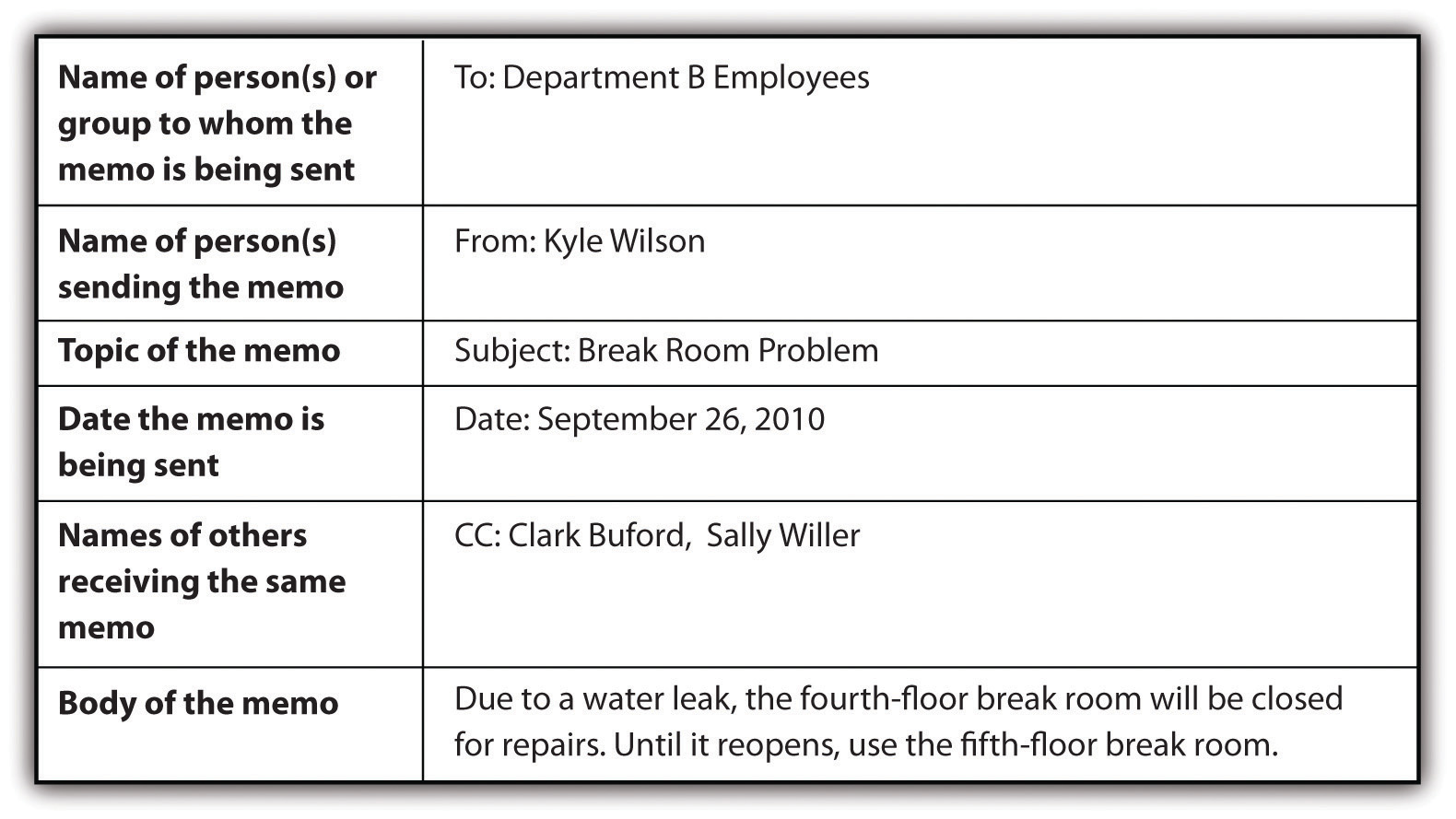
Companies often have blank memo forms in digital and hard-copy formats.
Figure 12.1 Example of a Blank Memo Form
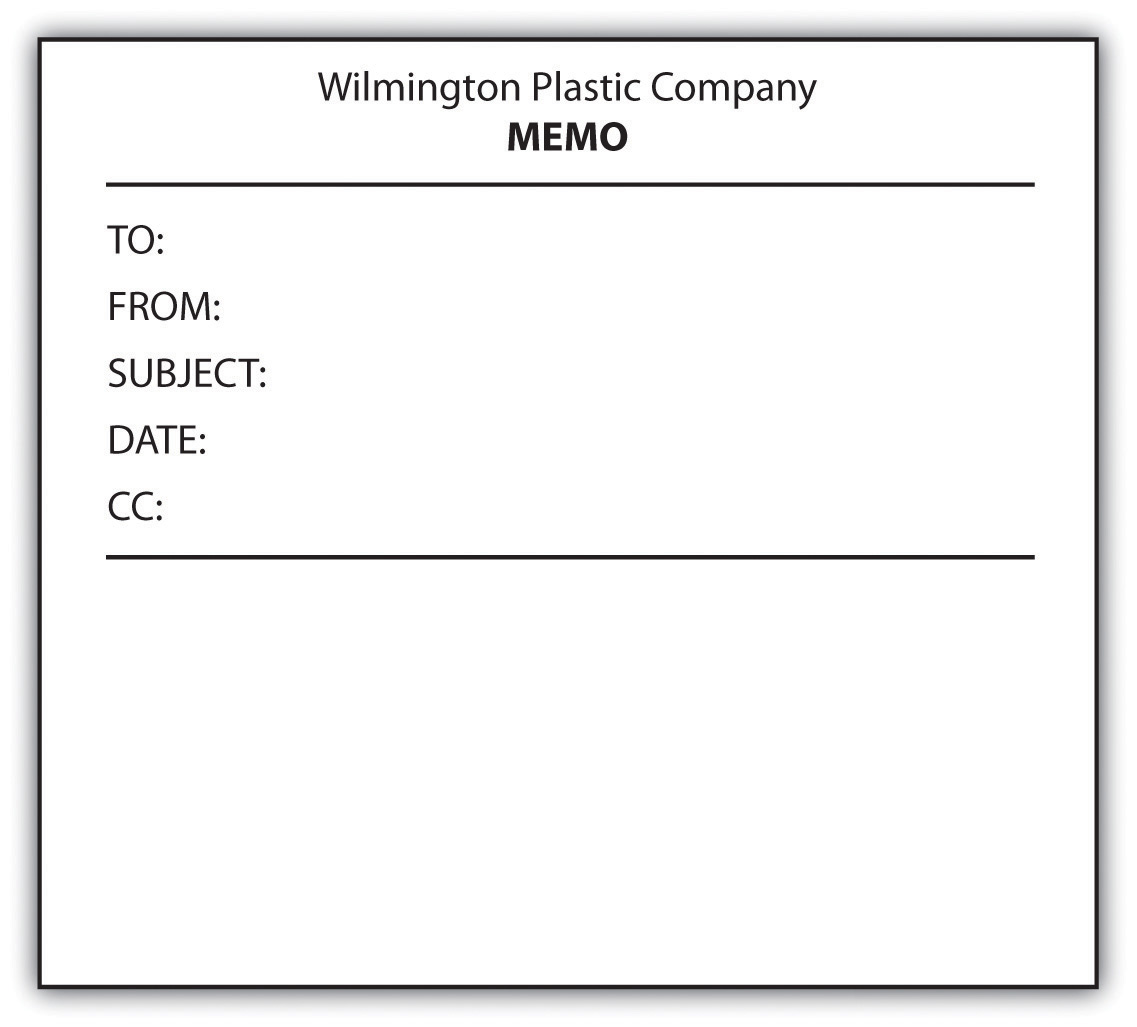
Key Takeaways
- Typically memos are short, are used for internal company matters, and cover a single issue.
- Typically memos include six parts: to, from, subject, date, carbon copy, and body text.
Exercises
- Make a list of five reasons a person might use a memo at work instead of sending an e-mail or mailing a business letter to employees.
- Create a memo form in your computer. Use your form to create a handwritten memo and a typed memo.
- Use a memo template for the next writer’s memo you submit with a college writing project. (See Chapter 5 "Planning" for more on how to develop a writer’s memo and a statement of purpose that describes message, audience, voice, attitude, reception, and tone.)
12.4 E-mail and Online Networking
Learning Objectives
- Recognize the dos and don’ts of business e-mails.
- Recognize online networking opportunities other than e-mailing.
- Describe ways to use online networking (other than e-mailing) for business purposes.
Online networkingCommunication that takes place over the Internet. refers to a variety of methods of talking to others over the Internet, including e-mailing. Since e-mailing is so common and has been around longer than the other methods, it will be dealt with as a separate entity here.
Using E-mail in the Workplace
E-mailing started small in the 1960s and became more widespread by the 1990s. Today the idea of going a day without e-mails is incomprehensible to many people, both professionally and personally. Even though most working people in the United States have both personal and work e-mail, workplace e-mail guidelines make the two quite different. Failing to follow these guidelines for workplace e-mails can have a range of ramifications from mild embarrassment to termination from your job. The following guidelines are general and most of them will apply in most workplaces. You are likely to find, however, that your workplace has its own guidelines that you will need to learn and follow.
Here are some general workplace e-mail guidelines:
- Make sure your writing has no grammatical, spelling, or punctuation errors and no typos. Any e-mail, whether it is sent internally or externally, reflects not only on the person sending it but also on the organization employing that person.
- Use standard wording, spelling, punctuation, and capitalization. Do not use any of the abbreviated, casual text that is common in personal online communications.
- Use a subject line that targets the key point of the e-mail so that the subject line can be a helpful sorting or searching tool.
- Be concise.
- Be courteous.
- Use jokes sparingly since they are often misunderstood.
- Use short paragraphs. Large blocks of digital text are difficult to read.
- Type in upper- and lowercase letters. Writing in all capital letters is perceived as shouting and writing in all lowercase letters is difficult to read.
- Keep in mind that electronic text is very easy to share with few or many. Don’t put anything in an e-mail that would be problematic if shared beyond your intended recipient.
- Most e-mail systems allow you to design and include a signature at the end of your e-mails, with the company name, your title, your e-mail address, and your phone number. Unless you are writing to a colleague with whom you have daily contact, plan to include your signature.
- When e-mailing a business acquaintance you do not know well, use a standard business letter greeting (“Dear Jack” or “Dear Mr. Wichel”) and closing (“Sincerely”). When you do know the person well, you can relax the greeting and closing a little if doing so would mesh with the culture of your company.
- Keep in mind that different computers and e-mail programs receive e-mail text differently. Do not rely on text features, such as bolding, italicizing, color, and underlining, to carry meaning.
- Clean up forwarded e-mails so that old e-mail components are not included unnecessarily or unintentionally.
- Take great care with your tone. A good way to check that your tone comes off accurately is to reread your e-mail aloud once you are finished writing it. If you sense that you are sending or replying to an e-mail out of anger or frustration, enforce an overnight cooling-off period before clicking the send button.
- If you make changes in your e-mail, reread the whole e-mail when you are finished to make sure you made any needed adjustments to accommodate the changes.
- Avoid using your work e-mail for personal messages, and especially avoid sending any messages or attachments that could be considered vulgar, offensive, or inappropriate. Keep in mind that all work e-mail might be monitored.
- Try not to send unusually large attachments that might clog the in-boxes of colleagues and coworkers, and keep your mailbox clean, so you don’t overtax the server space of your organization.
Using Other Online Networking
The e-mail guidelines in Section 12.4.1 "Using E-mail in the Workplace" also apply to other online networking situations. Whether you use other online networking tools will depend on your company. Having a general awareness of some of the other options is helpful when you join a company.
Table 12.1 "Some Other Online Networking Options" gives an overview of a few types of online networking options.
Table 12.1 Some Other Online Networking Options
| Networking Tool | Description |
|---|---|
| BlogsWeblog, or online journal. | Short for weblog, a blog is a personal online journal. Since blog content can show up in Internet searches, many businesses now maintain blogs as a means of sharing information with customers. |
| Niche networking sitesOnline site for communicating about a specific area of interest. | Specialty networking sites, such as for quilters, surfers, or vegans, serve as a hub for sharing ideas. |
| PodcastsAudio file that is posted online. | You can record and post audio files for others to download by subscription through a Real Simple Syndication (RSS) feed. |
| Professional networking sitesOnline communication location used for professional contacts. | Pay sites or sites with ad content can be used by job seekers to post their skills, by employers to find employees with needed skills, or by employees to network with others in the same field. |
| Social networking sitesOnline site intended for personal chatting. | Initially used only for personal interchanges, these are now also used by many businesses as a means of reaching out to customers. |
| Video sitesOnline location that can accommodate uploaded videos. | You can create video files and upload them onto the Internet for others to view. |
| WikisOnline location where groups can work together from different physical locations. | You can use these websites to collaborate on projects with invited group members. On such sites, group members at many different physical locations can work together by adding their input on a single document. |
| White-space social networking sitesOnline location where employees of a single company can meet and to which no one from outside the company has access. | These company networking sites are meant for internal communication and are not open to the public. |
Key Takeaways
- Business e-mails are online communications that are similar in many ways to business letters.
- To avoid misunderstandings, jokes should not be used in business e-mails.
- Due to the ease of sharing electronic text, you should make sure that your e-mail content will not embarrass you or cause other problems for you.
- Aside from e-mail, many other online networking opportunities abound, including blogs, niche networking sites, podcasts, professional networking sites, social networking sites, video sites, wikis, and white-space social networking sites.
Exercises
-
Reword the following e-mail subject lines in a more concise manner.
- Meeting at four o’clock for all departments members involved in the new product line.
- A faculty meeting will be held on Tuesday to discuss the new teacher lounge.
- Five customers have complained today that they have not received their orders.
- Delvin is out sick today so you need to find someone to cover for him.
- Our new blown glass vendor is offering some phenomenal deals.
-
Explain the problem with the following e-mail.
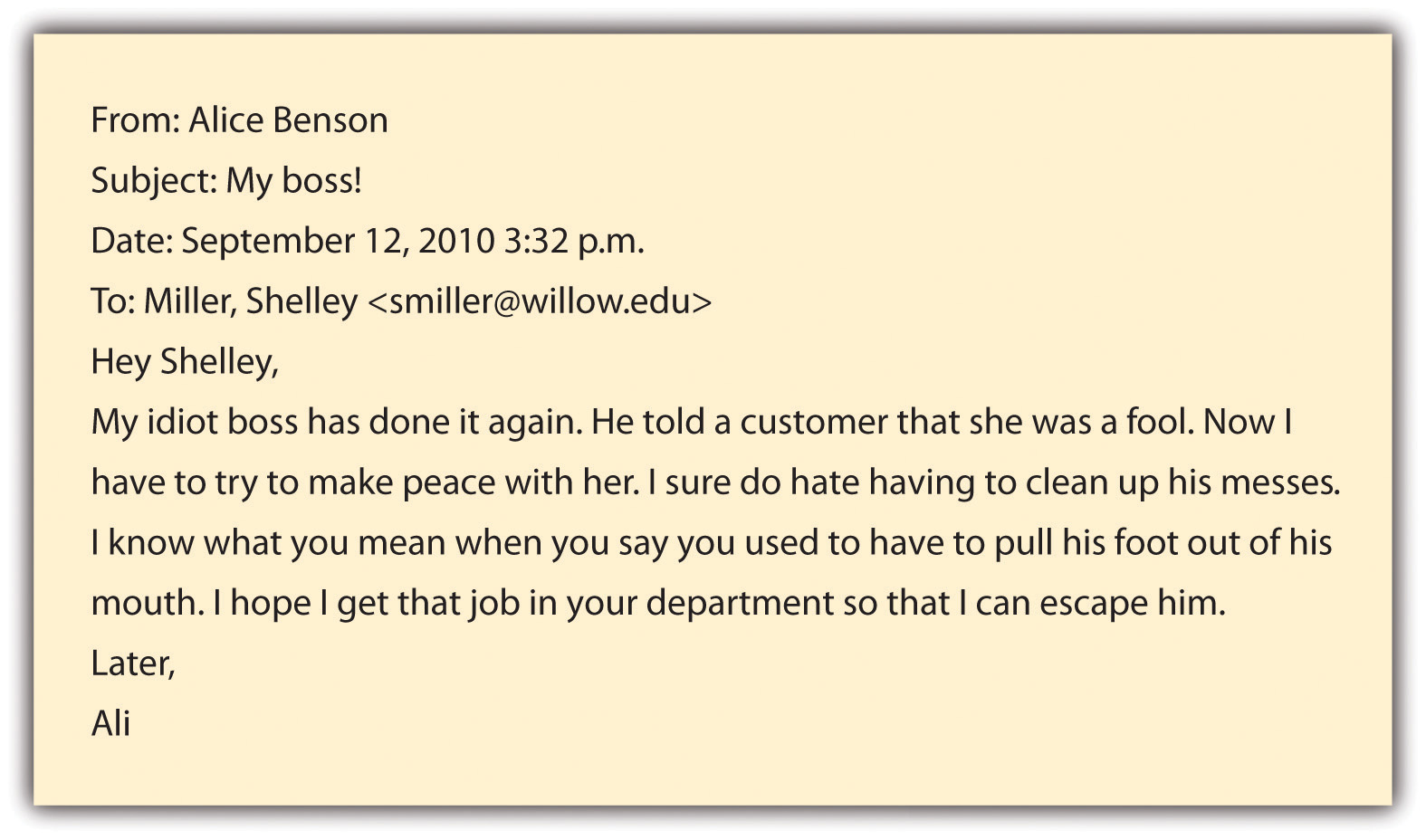
- Choose an online networking tool from among the many available on the web and write a brief report explaining how it works.




